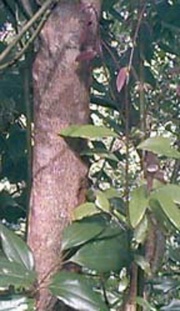Difference between revisions of "Cassia"
Jump to navigation
Jump to search
(username removed) |
|||
| (2 intermediate revisions by one other user not shown) | |||
| Line 4: | Line 4: | ||
An aromatic bark and oil obtained from the ''Cinnamomum cassia'' tree, native to China and southeast Asia. Cassia bark contains from 1 to 2 percent volatile oil, the principal component of which is cinnamic aldehyde. Small amounts of cassia oil were sometimes added to varnishes and resin as a plasticizer. Cassia oil is used as a cinnamon flavoring in candy, chocolates, and liqueurs. In classical times, oils with similar spicy smells from the African camphor tree (''Ocotea usumarensis'') native to east Africa were used in ancient Egypt (Serpico and White 2000). | An aromatic bark and oil obtained from the ''Cinnamomum cassia'' tree, native to China and southeast Asia. Cassia bark contains from 1 to 2 percent volatile oil, the principal component of which is cinnamic aldehyde. Small amounts of cassia oil were sometimes added to varnishes and resin as a plasticizer. Cassia oil is used as a cinnamon flavoring in candy, chocolates, and liqueurs. In classical times, oils with similar spicy smells from the African camphor tree (''Ocotea usumarensis'') native to east Africa were used in ancient Egypt (Serpico and White 2000). | ||
| − | + | See also [[cinnamon%20oil|cinnamon oil]]. | |
| − | |||
| − | See also [ | ||
== Synonyms and Related Terms == | == Synonyms and Related Terms == | ||
| Line 12: | Line 10: | ||
''Cinnamomum cassia''; canelo de China (Esp.); olio di cannella (It); Chinese cinnamon oil; cinnamon; cassia oil; cinnamon oil | ''Cinnamomum cassia''; canelo de China (Esp.); olio di cannella (It); Chinese cinnamon oil; cinnamon; cassia oil; cinnamon oil | ||
| + | ==Physical and Chemical Properties== | ||
{| class="wikitable" | {| class="wikitable" | ||
|- | |- | ||
| Line 18: | Line 17: | ||
|} | |} | ||
| − | == | + | ==Resources and Citations== |
| − | |||
| − | |||
| − | + | * M.Serpico, R.White, "Oil, fat and wax" in ''Ancient Egyptian Materials and Technology'', P.Nicholson, I.Shaw (eds.), Cambridge University Press, 2000, p. 390-429. | |
* G.S.Brady, ''Materials Handbook'', McGraw-Hill Book Co., New York, 1971 Comment: p. 200 | * G.S.Brady, ''Materials Handbook'', McGraw-Hill Book Co., New York, 1971 Comment: p. 200 | ||
| Line 32: | Line 29: | ||
* ''The American Heritage Dictionary'' or ''Encarta'', via Microsoft Bookshelf 98, Microsoft Corp., 1998 | * ''The American Heritage Dictionary'' or ''Encarta'', via Microsoft Bookshelf 98, Microsoft Corp., 1998 | ||
| − | * ''Encyclopedia Britannica'', http://www.britannica.com Comment: "Cinnamon." | + | * ''Encyclopedia Britannica'', http://www.britannica.com Comment: "Cinnamon." Accessed 18 Aug. 2004 . |
[[Category:Materials database]] | [[Category:Materials database]] | ||
Latest revision as of 15:57, 20 May 2022
Description
An aromatic bark and oil obtained from the Cinnamomum cassia tree, native to China and southeast Asia. Cassia bark contains from 1 to 2 percent volatile oil, the principal component of which is cinnamic aldehyde. Small amounts of cassia oil were sometimes added to varnishes and resin as a plasticizer. Cassia oil is used as a cinnamon flavoring in candy, chocolates, and liqueurs. In classical times, oils with similar spicy smells from the African camphor tree (Ocotea usumarensis) native to east Africa were used in ancient Egypt (Serpico and White 2000).
See also Cinnamon oil.
Synonyms and Related Terms
Cinnamomum cassia; canelo de China (Esp.); olio di cannella (It); Chinese cinnamon oil; cinnamon; cassia oil; cinnamon oil
Physical and Chemical Properties
| CAS | 8007-80-5 |
|---|
Resources and Citations
- M.Serpico, R.White, "Oil, fat and wax" in Ancient Egyptian Materials and Technology, P.Nicholson, I.Shaw (eds.), Cambridge University Press, 2000, p. 390-429.
- G.S.Brady, Materials Handbook, McGraw-Hill Book Co., New York, 1971 Comment: p. 200
- Richard S. Lewis, Hawley's Condensed Chemical Dictionary, Van Nostrand Reinhold, New York, 10th ed., 1993
- Random House, Webster's Encyclopedic Unabridged Dictionary of the English Language, Grammercy Book, New York, 1997
- The American Heritage Dictionary or Encarta, via Microsoft Bookshelf 98, Microsoft Corp., 1998
- Encyclopedia Britannica, http://www.britannica.com Comment: "Cinnamon." Accessed 18 Aug. 2004 .
